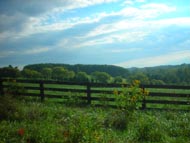Publications
2024
2021
- Age-dependence of the demographic rates survival, fecundity and individual growth is a fundamental aspect of population biological theory. Knowledge about plant ageing can also be important for conservation and agriculture as it will improve the accuracy of population viability assessments and long-term performance assessments in perennial crops. Recent studies show age effects on demographic rates for several plant species, yet much remains to be learned about the patterns and mechanisms of plant ageing, particularly about how age effects interact with the environment and with plant size.
- We collected age-and-size-based demographic data, as well as individual-based environmental data, for the perennial herb Plantago lanceolata in Denmark over three annual transitions (4 years). We combined frequent field monitoring of carefully mapped individuals with the underused technique of root histology to determine age of herbaceous plants. We used generalized linear mixed effects models to assess how age, soil properties and year influenced survival, growth and reproduction.
- Our results show no strong evidence of consistent age declines, rather, we found mostly positive effects of age on vital rates. For all vital rates, i.e. survival, growth, flowering and reproductive output, age effects also differed significantly among years. Additionally, we detected an interactive effect of age and size in the growth model. Size, and temporal and spatial environmental variation also affected vital rates independently of age.
- Synthesis. Our study shows that age-dependence of demographic rates can depend both on individual size and environmental variation. These results suggest that a consideration of potential age-interactions may improve the accuracy of comparative studies of ageing and population projections. Moreover, this study shows that much is still unknown about how plant ageing can be affected by the environment.
Oxidative stress and hormonal regulation are hallmarks of a/biotic stress responses in plants. However, little is known about their linkage with whole-organismal mortality in long-lived species. Here, we examined the validity of photo-oxidative stress markers and stress-related phytohormones as predictive proxies of mortality risk in the perennial herb Plantago lanceolata. Capitalizing on its broad ecological niche, we examined photo-oxidative stress markers (Fv/Fm ratio, contents of chlorophylls, carotenoids, and tocochromanols, and the extent of lipid peroxidation) and stress-related phytohormones (ABA, salicylic acid and jasmonates contents) as proxies of mortality in three populations of sub-tropical and Mediterranean habitats: Virginia (VA, U.S.A.), Catalonia (CAT, Spain), and Queensland (QLD, Australia). Stress markers were measured together with the vital rates of survival, growth, and reproduction on a total of 279 individuals. Stress marker data were collected during the summer and death/survival was monitored after two and four months. Whole-organism mortality was similarly high in both sub-tropical non-native populations (ca. 30 % after a drought in VA and QLD), but lower in the native population (ca. 10 % in CAT). The contents of antioxidants (lutein, zeaxanthin, β-carotene) and the de-epoxidation state of the xanthophyll cycle (DPS) were good proxies of mortality risk in VA and QLD. DPS and all carotenoid contents per unit of chlorophyll were lower four months in advance in dead than in alive plants in VA and QLD, thus suggesting reduced photoprotective capacity increased the mortality risk in non-native populations. We show that whole-organismal mortality in P. lanceolata is associated with a reduced capacity to enhance photoprotection under abiotic stress conditions. The validity of various stress markers as predictive proxies of mortality risk is discussed.
Genetic differentiation and phenotypic plasticity jointly shape intraspecific trait variation, but their roles differ among traits. In short-lived plants, reproductive traits may be more genetically determined due to their impact on fitness, whereas vegetative traits may show higher plasticity to buffer short-term perturbations. Combining a multi-treatment greenhouse experiment with observational field data throughout the range of a widespread short-lived herb, Plantago lanceolata, we (1) disentangled genetic and plastic responses of functional traits to a set of environmental drivers and (2) assessed how genetic differentiation and plasticity shape observational trait–environment relationships. Reproductive traits showed distinct genetic differentiation that largely determined observational patterns, but only when correcting traits for differences in biomass. Vegetative traits showed higher plasticity and opposite genetic and plastic responses, masking the genetic component underlying field-observed trait variation. Our study suggests that genetic differentiation may be inferred from observational data only for the traits most closely related to fitness.
2020
Artificial light at night (ALAN) has been shown to alter aspects of plant growth, but we are not aware of any studies that have examined whether the effects of ALAN on plants depend upon the backdrop of variation in other abiotic factors that plants encounter in field populations. We conducted a field experiment to investigate whether ALAN affects the growth and anti-herbivore defenses of common milkweed, Asclepias syriaca, and whether the effects of ALAN are influenced by plant density or soil moisture content. Artificial light at night, soil moisture, and plant density were manipulated according to a split-plot factorial design. Although increasing soil moisture by watering had no significant effects on latex exudation, attributes of plant growth generally responded positively to watering. The basal stem diameter (BSD) and height of plants were affected by ALAN × soil moisture interactions. For both of these variables, the positive effects of ALAN were greater for plants that were not watered than for plants that were. Basal stem diameter was also affected by an ALAN × plant density interaction, and the positive effect of ALAN on BSD was greater in the low-density treatment than in the high-density treatment. Our results demonstrate that the effects of ALAN on plant growth can be altered by soil moisture and plant density. Consequently, the effects of ALAN on plants in nature may not be consistent with existing frameworks that do not account for critical abiotic variables such as water availability or biotic interactions between plants such as competition.
